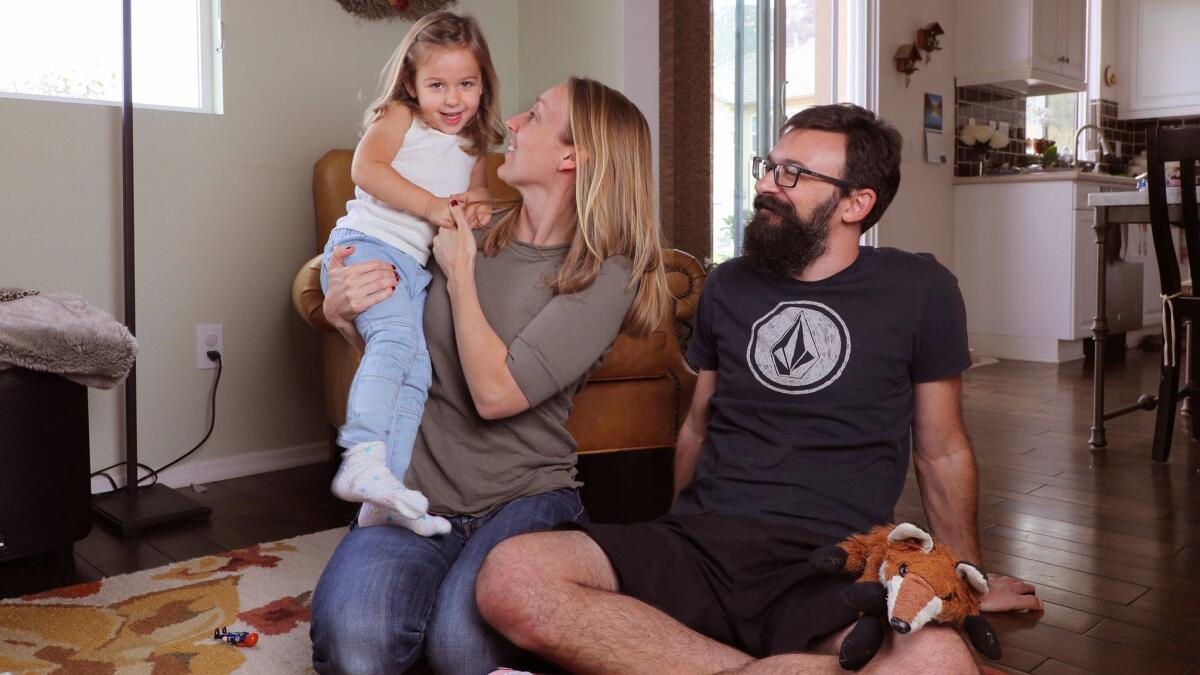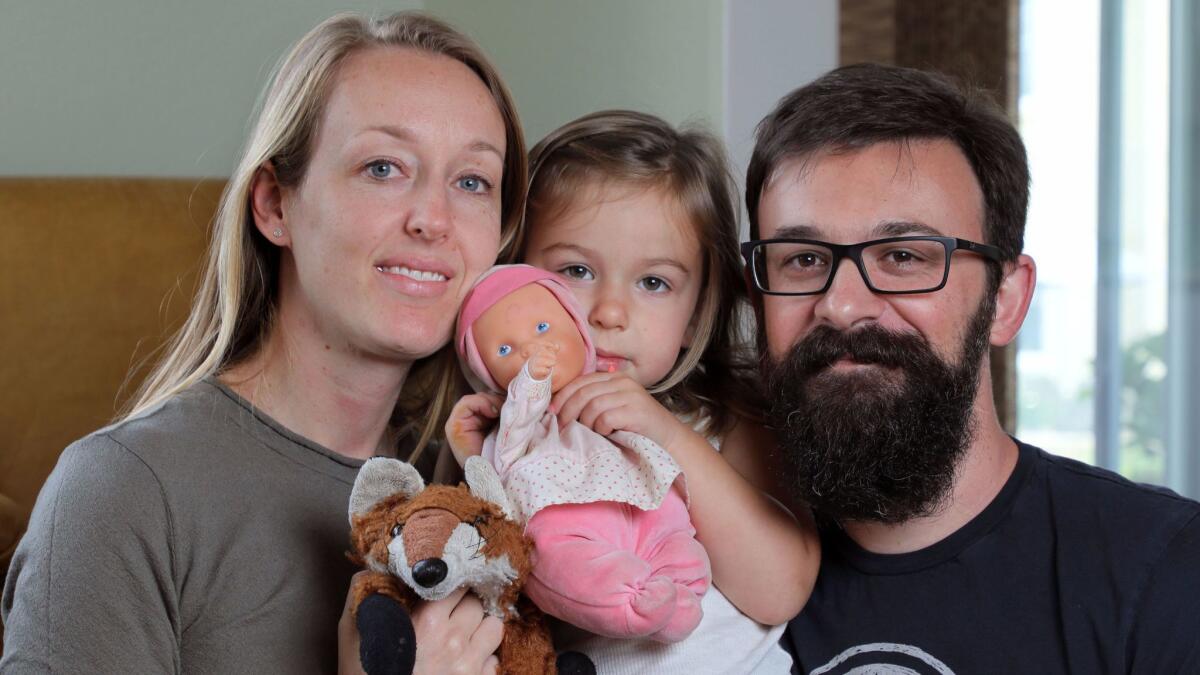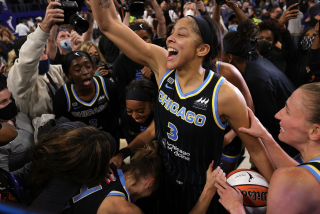Community mourns boy who inspired ‘Hope for Parker’ campaign
- Share via
Fallbrook — Early next month, a grieving Fallbrook couple will host a free public event to thank the community and celebrate the life of their late son, whose devastating, yearlong struggle with pediatric brain cancer was followed by nearly 18,000 people worldwide.
On Feb. 20, 6-year-old kindergartner Parker Landis passed away after a 13-month battle with diffuse intrinsic pontine glioma, a rare brainstem cancer that strikes children ages 6-10. The survival rate for DIPG is less than 1 percent, with an average life expectancy of just 9 months after diagnosis.
Parker’s parents, Mark and Jennifer Landis, knew their son’s illness was terminal when they got his diagnosis on Jan. 17, 2016. But they never stopped fighting, and their roller-coaster journey — chronicled with Mark’s raw, honest posts and touching photographs on the Facebook page “Hope for Parker” — inspired a community support campaign that still continues.

“After we got the diagnosis we kept it to ourselves until we could digest it, but when we went public we were overwhelmed with the outpouring of public support,” Jennifer said. “There’s no way we could’ve done what we did without the support. I’m glad that we could be there to hold his hand until the end. We never left his side.”
Over the past year, the Landises were the beneficiaries of a community carnival, a crowdfunding campaign that raised nearly $60,000, numerous individual fundraisers and a “meal train” of home-cooked meals that are still arriving on their doorstep. The Make-A-Wish Foundation also granted Parker’s wish for a family trip to Hawaii last year, though he was too ill at the time to enjoy it.
The money raised allowed the Landises to take leaves from their jobs — he’s a software engineer, she’s a pharmacist — and to fund nearly a dozen trips to New York last year for a high-profile clinical trial that might someday lead to a cure for DIPG.
Since Parker’s death, the Landises say they’ve been struggling through each day in a state of shock. They avoid phone conversations and don’t leave the house much. Jennifer’s not sure when she’ll return to work.
“I think this will always be hard,” said Jennifer, 35. “We will always be a family of four minus one, not a family of three.”
Up until last year, the Landises thought they’d exhausted their share of bad luck. They lost everything they owned (except for their cat and a laptop computer) when the Witch Creek Fire swept unexpectedly into their Rancho Bernardo neighborhood in the pre-dawn hours of Oct. 22, 2007.
“We thought that would be the worst thing in our lives forever,” Jennifer said. “This foreign force had entered our sacred space and took everything.”
Mark, 38, said the shock of their sudden loss haunted him for many years. Now it seems insignificant.
The couple met in 1995 when they were students at Rancho Bernardo High School (she was a freshman, he, a junior) and they’ve been together ever since. They married in 2004 and six years later welcomed their first child, Parker Steven (their bubbly, talkative daughter Taylor is now 3).
Parker was a thriving, goofy, introspective boy who loved to swim, ride his bike and lead the neighborhood children around the cul-de-sac dressed in his beloved Captain America costume. Most weekends Jennifer worked, so Mark took a big hand in child-rearing.
“I was grateful. A lot of fathers don’t have that alone time in the early years with their child,” Mark said. “He was my little buddy. We got into all sorts of trouble together.”
In retrospect, the couple say they now realize the first symptoms of Parker’s illness were appearing in fall 2015, when his behavior became a bit more cranky and clingy and he seemed a little clumsy.
“Once he tripped while we were walking and I asked him what happened. He said ‘my leg stopped working.’ I didn’t think anything of it at the time,” Mark said.
Then one Friday after school, Mark found Parker sound asleep on the floor at daycare. As they walked to the car, Parker was groggy and stumbling. He would later be diagnosed with strep throat, so the Landises initially thought the boy’s fever was virus-related.
The next morning, Parker began vomiting and holding one eye shut when he watched TV, so Jennifer took him and Taylor to the pediatrician for a check-up. When the doctor saw that Parker’s eyes couldn’t follow his finger back and forth, he feared an infection behind the eyes.
An ambulance rushed Parker to a nearby emergency room, where an MRI showed a lemon-sized mass in his brain. Twenty-four hours later, now at Rady Children’s Hospital, the final diagnosis came in. The Landises say they don’t much remember that day, other than feeling numb, helpless and confused.
DIPG is what’s known as an orphan disease. It’s so rare (1 in a million children, with only about 300 cases diagnosed each year in the U.S.) that it gets scant money for research.
One of just a handful of DIPG clinical researchers worldwide is Dr. Mark Souweidane, who last spring was seeking diagnosed patients for a Phase 1 clinical trial in New York. Hundreds of chemotherapy trials for DIPG had failed, but Souweidane had pioneered a way to surgically deliver drugs directly to the brainstem.
Rather than take their son home to die, the Landises decided to go for the moonshot and apply for the trial. A few weeks later, Parker was accepted as Patient No. 26.

The time off and expense of travel would require more resources than the couple had, so after two weeks of difficult discussions, they launched a crowdfunding campaign and accompanying Facebook page.
Jennifer said it was hard exposing their lives to strangers.
“I didn’t want to sacrifice our son’s dignity. It’s like we were the car crash on the side of the road and people were driving by looking at it.”
Mark said the page was initially created as a necessity, but eventually it became a therapeutic way to express the struggle he and Jennifer were going through. On the page he promoted fundraisers for other children with DIPG and for disease research. And he published dozens of photos of Parker enjoying brief respites of health and often sleeping after procedures. The Landises refused to publish any photos that showed their son suffering.
“People might’ve wanted to see the car crash, but we weren’t going to show that,” he said.
Parker would later be written up in news articles and the doctor’s blog as the first trial patient to receive the highest dose of the new drug and the only one of the 31 patients to endure three surgical infusions.
The drug’s results were inconclusive — almost all of the young patients have since passed from the disease — but it did prove that the drug-delivery procedure was survivable.
The Landises say they hope their son’s participation helped contribute to a future cure. They live by a pact not to regret the treatment choices they made for their son.
“Last year was a roller-coaster. We had a lot of hope, then not hope, then hope again, then not hope after that,” she said. “Parents who get this diagnosis, we all go in different directions because we’re so desperate. But in the end it all ends up the same. They all pass away.”
Parker’s health seesawed between six-week bouts of vitality after a month of radiation last spring and after the first surgery in New York last June. But by fall, hope began to fade.
He first lost the use of his arms, then his legs, then his ability to speak. In December he was placed on hospice. As Parker’s death neared, Mark’s posts on Facebook became more sporadic. In the final weeks there were no words, just a series of photos of Parker taken before he got sick so people could remember him for how he lived, not how he died.
They’re now working together on Parker’s “celebration of life” service, which will be detailed on the “Hope for Parker” page in the coming weeks. It will take place at 3:30-5:30 p.m. April 9 at the Grand Tradition Estate, 220 Grand Tradition Way in Fallbrook. For Parker’s friends and former classmates, there will be a bounce house, face painting and fire trucks.
Mark said that although the experience of the past year was unimaginably sad, it was also inspiring in how so many people, friends and strangers, locally and abroad, reached out to offer support and words of encouragement online.
“I’d like to say I’ve found some enlightenment,” he said. “I’m so much more compassionate than I used to be and I have no problem expressing my feelings now ... Before this, I didn’t really know what death was, but now I understand it. There’s horror in it, but there’s a beauty, too.”
Celebration of Life for Parker Landis
When: 3:30-5:30 p.m. April 9
Where: The Grand Tradition, 220 Grand Tradition Way, Fallbrook
Details: https://www.facebook.com/events/364303683969187/



